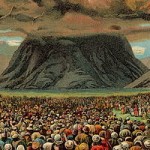The king & the national assembly – Vayelech
 Every seven years, according to sidra, the people were to gather at the Temple for the hakhel (the word means “assemble”) ceremony in which the king read aloud passages from D’varim.
Every seven years, according to sidra, the people were to gather at the Temple for the hakhel (the word means “assemble”) ceremony in which the king read aloud passages from D’varim.
The source of the mitzvah is Deut. 31:10-13.
An earlier passage – Deut. 4:10 – describes the Revelation at Sinai with the same verb, hakhel (“Assemble the people and I will make them hear My words…”).
It appears that the two events, the seven-yearly hakhel and the assembly of the people at Sinai, are equivalent.
The hakhel ceremony is therefore a regular re-enactment of Sinai, and the king takes the place of Moses in proclaiming the word of God to the gathering.
Each generation thus stands in the shoes of the Israelites of Moses’ time. Each generation pledges itself to the acceptance of the Torah as did the generation of the Revelation.
In a sense each generation is becoming Jewish all over again, which explains why proselytes are especially expected to take their place at the hakhel (Maimonides, Chagigah 3:6).
The fact that passages from D’varim are read to them amongst the entire assembly may be because the fifth book of the Torah begins with a summary of history, proceeds with the Shema and continues with the second version of the Ten Commandments, suggesting that the convert, like every Jew, must identify with the history and destiny of the Jewish people, affirm Jewish belief, and undertake to live by the commandments.



